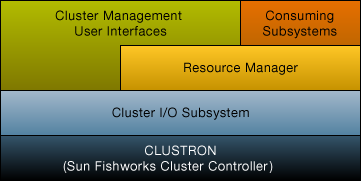Understanding Clustering
The clustering subsystem incorporated into the series consists of three main building blocks (see the following figure). The cluster I/O subsystem and the hardware device provide a transport for inter-controller communication within the cluster and are responsible for monitoring the peer's state. This transport is used by the resource manager, which allows data service providers and other management subsystems to interface with the clustering system. Finally, the cluster management user interfaces provide the setup task, resource allocation and assignment, monitoring, and takeover and failback operations. Each of these building blocks is described in detail in the following sections.
Figure 2 Clustering Subsystem

Unconfiguring Clustering
Unconfiguring clustering is a destructive operation that returns the clustered controllers to standalone controllers. There are two reasons to unconfigure clustering:
-
You no longer wish to use clustering; instead, you wish to configure two independent storage appliances.
-
You are replacing a failed storage controller with new hardware or a storage controller with factory-fresh appliance software (typically this replacement is performed by your service provider).
The peer node must be turned off before unconfiguration can occur. The peer node must be factory reset before being used again in the same clustered configuration.
 | Caution - Because unconfiguring a cluster may result in data loss, contact Oracle support. |